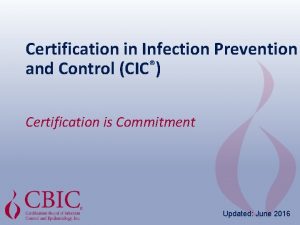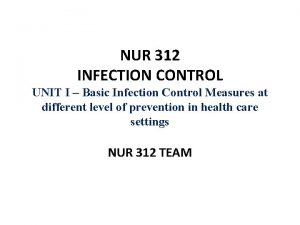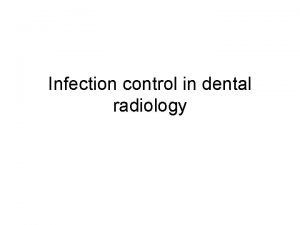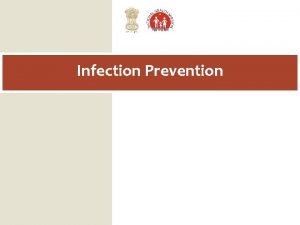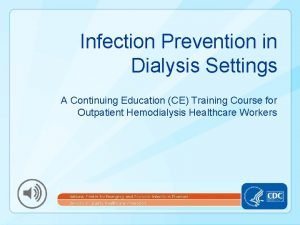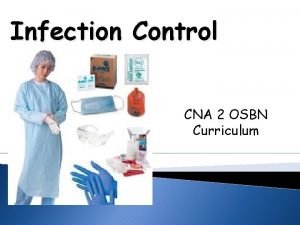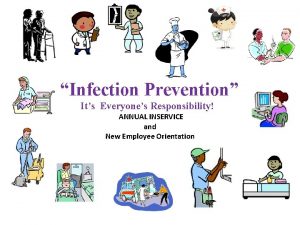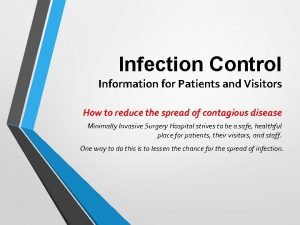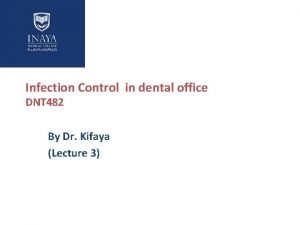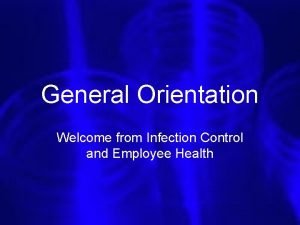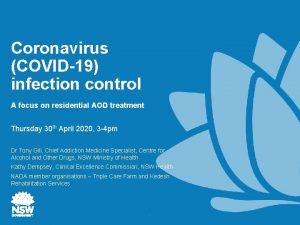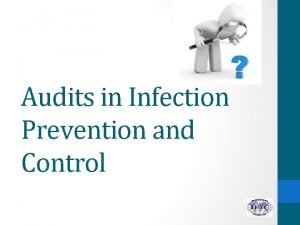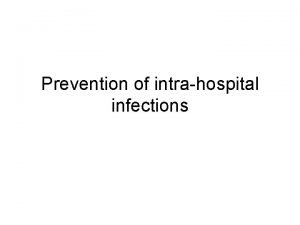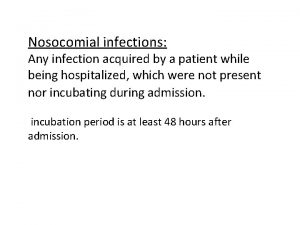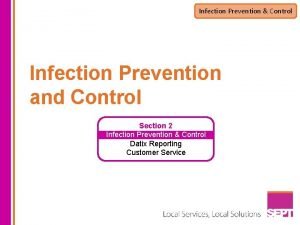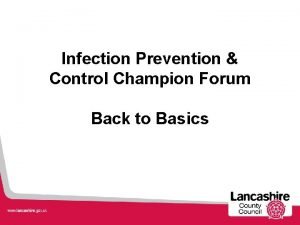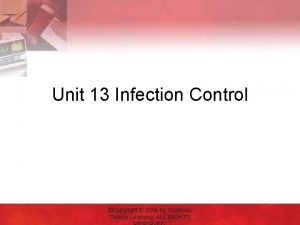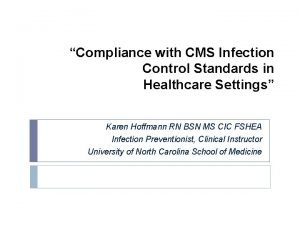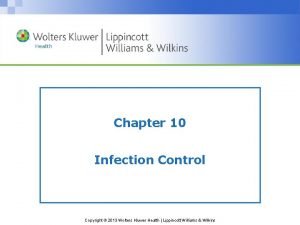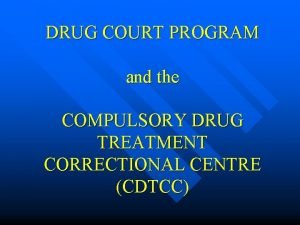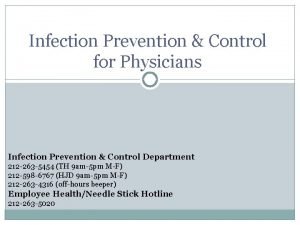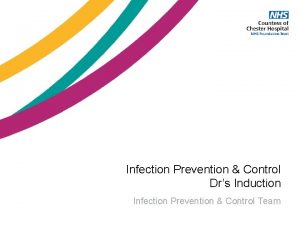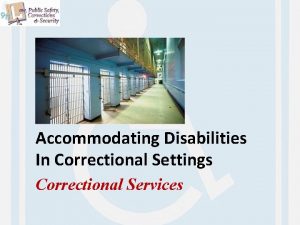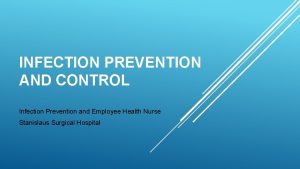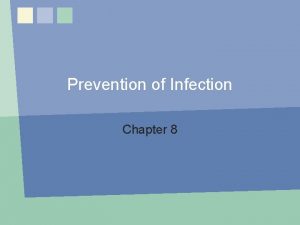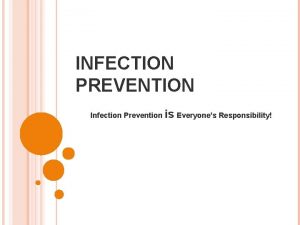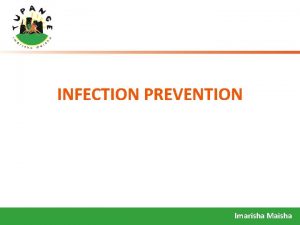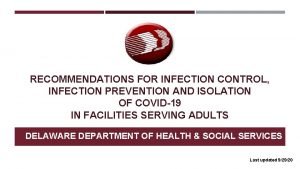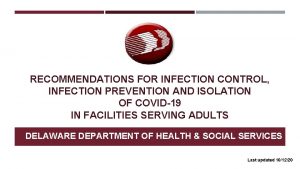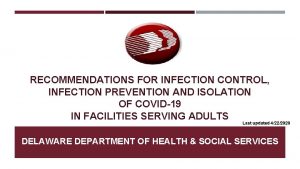Infection Prevention and Control in Correctional Settings Carolyn











































- Slides: 43

Infection Prevention and Control in Correctional Settings Carolyn Herzig, MS, Ph. D(c) Columbia University School of Nursing, Center for Health Policy Columbia University Mailman School of Public Health, Department of Epidemiology Hosted by Nicole Kenny Virox Technologies Inc. www. webbertraining. com March 12, 2015

Learning objectives Review infection control challenges specific to correctional settings Discuss prevalence and transmission of common infectious diseases Identify strategies to prevent transmission and opportunities for improvement 2

Role of correctional system (Re-) incarceration Post-release exposures Dissemination Awofeso, 2010 Concentration Amplification 3

Correctional settings Jails • Short term • Locally operated Prisons • Longer term • Operated by state or federal governments 4

Correctional populations About 6. 9 million American residents were under the supervision of the adult correctional system at the end of 2013 1 in 110 adults were incarcerated About 1. 6 million in federal or state prisons About 730, 000 in local jails About 630, 000 admissions and 620, 000 releases from prisons 67% of released prisoners were arrested for a new crime within 3 years; 77% were arrested within 5 years Glaze, 2014; Carson, 2014; Durose, 2014 5

Inmate health Prevalence of ever having a disease among prison and jail inmates (20112012) Maruschak, 2015 Prison inmates Jail inmates General populatio n % SE TB 6. 0 0. 6 2. 5 0. 3 0. 5 0. 1 Hepatitis 10. 9 1. 0 6. 5 0. 5 1. 0 0. 1 Hepatitis B 2. 7 0. 4 1. 7 0. 2 - - Hepatitis C 9. 8 1. 0 5. 6 0. 5 - - STIs 6. 0 0. 5 6. 1 0. 5 3. 5 0. 1 HIV/AIDS 1. 3 0. 3 1. 3 0. 2 0. 3 0. 1 6

Learning objectives Review infection control challenges specific to correctional settings Discuss prevalence and transmission of common infectious diseases Identify strategies to prevent transmission and opportunities for improvement 7

Challenges to infection control Priorities Sharing Hygiene Crowding Medical care Expertis e Moveme nt 8

Challenges to infection control Priorities Security and safety Medical care Confidentiality Resources Variation across facilities 9

Challenges to infection control Expertise Disease management Movement Transfer between facilities Movement within facility Maintaining continuity of care 10

Challenges to infection control Crowding Lack of single cells Large dormitories Enclosed spaces Hygiene Hand personal hygiene Laundry Housekeeping 11

Challenges to infection control Sharing Personal items Equipment used for tattooing, piercing, injection drug use Exercise equipment 12

Learning objectives Review infection control challenges specific to correctional settings Discuss prevalence and transmission of common infectious diseases Identify strategies to prevent transmission and opportunities for improvement 13

Common infectious diseases Tuberculosis (TB) HIV infection Viral hepatitis Hepatitis B virus (HBV) Hepatitis C virus (HCV) Methicillin-resistant Staphylococcus aureus (MRSA) 14

Tuberculosis Overview Transmitted via airborne respiratory droplets In the US, many cases of TB arise among individuals who are overrepresented in jails and prisons Infection usually requires prolonged contact with an infected individual in an enclosed space 5% of infected individuals develop active TB during the first year or two following infection 15

Tuberculosis Prevalence US infection rate: 5 -10% Rates throughout the world vary widely: 32% on average 4 -6% of US cases were living in correctional facilities when diagnosed Prevalence of LTBI in correctional settings can be as high as 25% Risk factors Foreign born from high-incidence country Injection drug use Close contact with an active TB case HIV infection 16

TB Strategies Early detection Early identification and isolation of active TB cases is critical Education During orientation and when appropriate Screening Various strategies recommended: Symptoms, Chest radiograph, TST, IGRA All inmates should be screened for symptoms at intake Ongoing surveillance for active TB Detection of latent TB infection In general, TST should be performed at intake, annually, if active disease is suspected, as part of a contact investigation 17

TB Strategies Treatment Active TB cases LTBI to prevent disease development Contact investigations Initiation depends upon index case characteristics Identify new active cases Identify and treat inmates with new LTBI Multi-disciplinary team Isolation Inmates with suspected pulmonary TB Airborne Infection Isolation (AII) room Use airborne precautions and personal respiratory protection 18

HIV Infection Overview Bloodborne pathogen spread through percutaneous and mucosal exposures to infectious blood and body fluids Challenges related to continuing treatment despite frequent movement and protecting against other diseases Prevalence Among prison inmates in 2010, prevalence of HIV/AIDS cases was 1. 5% and prevalence of confirmed AIDS cases was 0. 5% Rate of HIV among prison inmates has declined from 194 cases per 10, 000 inmates in 2001 to 146 cases per 10, 000 inmates in 2010 Maruschak, 2012 19

HIV Infection Risk factors Consensual and nonconsensual sexual activity 4 -30% of inmates reported sexual activity while incarcerated Injection drug use 3 -28% adult inmates reported IDU during incarceration Tattooing or piercing with contaminated equipment Open wound Weinbaum, 2005 20

HIV Strategies Education/Counseling During orientation and when appropriate For all inmates about the importance of preventing blood exposures Reinforce risk reduction for HIV infected inmates Adherence to medication schedules Testing All sentenced inmates should be offered HIV testing at the time of incarceration Voluntary (opt-in, opt-out) Mandatory Involuntary Continuity of care When transferred to another facility or returning to the community 21

Hepatitis B virus Overview Bloodborne pathogen spread through percutaneous and mucosal exposures to infectious blood and body fluids Acute and chronic infection Prevalence Up to 47% of prison inmates have serologic evidence of HBV infection 1 – 3. 7% of prison inmates have chronic infection Risk factors Sexual activity and injection drug use Tattooing or piercing with contaminated equipment Sharing personal items such as clippers, razors, or toothbrushes 22

HBV Strategies Education During orientation or when appropriate Screening Strategies are available using various serological markers Baseline screening recommended for sentenced inmates with risk factors Vaccination Should be considered for at-risk inmates 23

Hepatitis C virus Overview Bloodborne pathogen spread through percutaneous exposures to infectious blood Acute and chronic infection Prevalence Up to 41% of prison inmates have serologic evidence of HCV infection 12 – 31% of prison inmates have chronic infection Risk factors Injection drug use Sexual activity Tattooing or piercing with contaminated equipment Spaulding, 2006 24

HCV Strategies Education/Counseling During orientation or when appropriate Risk reduction and substance abuse treatment Screening Recommended for inmates with risk factors 25

MRSA Overview Leading cause of skin and soft tissue infections (SSTIs) in communities throughout the US (MSSA is also a common cause of SSTIs) Transmission is person-to-person via contaminated hands or environment Can be transmitted by individuals with asymptomatic carriage Prevalence About 30% of healthy individuals in the community are asymptomatically colonized with S. aureus <1. 5% colonized with MRSA in the community 1 -16% colonized with MRSA in correctional settings 26

MRSA Risk factors History of MRSA infection or colonization, “spider bite” Close contact with someone with an infection Recent antibiotic use Crowded living conditions Poor personal hygiene (e. g. , infrequent showering) Sharing soap, towels, and exercise equipment Sharing injection drug and tattooing equipment Draining own abscesses 27

MRSA Strategies Education Prevention, transmission, treatment Hand personal hygiene Seeking medical evaluations when appropriate Screening/Surveillance Evaluate for skin infections at intake and during examinations Recently hospitalized and at-risk inmates Review of bacterial culture reports and determination of predominant circulating pathogen Environment Appropriate sanitation measure 28

MRSA Strategies Antibiotic use Antibiotic prescribing practices should be monitored to reduce development of resistance Hand hygiene Training for correctional staff, health care workers, inmates Monitoring and supplies Correctional standard precautions & contact precautions Adapted from hospital standard precautions Account for housing area sanitation and specific modes of transmission Housing/Transfers Appropriate housing decisions based on a number of factors Do not transfer until fully evaluated and treated 29

MRSA Strategies Outbreaks Similar antibiotic susceptibility profiles among 2 or more isolates from epidemiologically linked inmates Enhanced infection control measures Surveillance Detect potential modes of transmission Education for inmates and correctional staff Decolonization Not routinely recommended but considered on a case-bycase basis for recurrent infections and in outbreak situations 30

HIV testing in prisons (2012) Intake 17 Mandatory 42 Inmate request 11 Opt-out 39 Clinical indication 10 Opt-in While in custody 34 Involved in incident 5 On assessment 20 Offered during routine exam 2 Inmate request 19 High-risk Maruschak, 2015 31

Hepatitis testing in prisons Based on survey responses from 44 US correctional systems (2009): Among 1584 state prisons (2000): 43 Intake HBV 28 Inmate request 38 Physician request 33 Risk factors Hill, 2010; Beck, 2004 79% Tested HCV 4% Risk factors 5% Inmates in custody 32

Prison and jail inmates tested (20112012) Maruschak, 2015 % Prison inmates % Jail inmates HIV 71 11 TB 94 54 Hepatitis B 57 6 Hepatitis C 54 6 STIs 33 5 33

Learning objectives Review infection control challenges specific to correctional settings Discuss prevalence and transmission of common infectious diseases Identify strategies to prevent transmission and opportunities for improvement 34

Opportunities for improvement Inmates are disproportionately affected by infectious diseases High-risk behaviors occur outside of correctional settings Incarceration provides opportunity to reach underserved populations with health care services and prevention initiatives 35

Opportunities for improvement Comprehensive screening programs Condom availability Needle exchange programs Education about risk reduction and prevention 36

Opportunities for improvement Enhanced information exchange Disease surveillance Collaborative approaches including correctional health care, public health departments, corrections professionals 37

Resources CDC Correctional Health http: //www. cdc. gov/correctionalhealth/ Federal Bureau of Prisons http: //www. bop. gov/ National Commission on Correctional Health Care http: //www. ncchc. org/ American Correctional Association http: //www. aca. org/ACA_Prod_IMIS/ACA_Member/ Home. ACA_Member/Home. aspx 38

References Awofeso N. Prisons as social determinants of hepatitis C virus and tuberculosis infections. Public Health Rep. 2010 Aug; 125 Suppl 4: 25– 33. Beck AJ, Maruschak LM. Hepatitis Testing and Treatment in State Prisons. Bureau of Justice Statistics Special Report (Publication No. NCJ 199173 C). Washington, D. C. : U. S. Department of Justice; 2004. Bick JA. Infection control in jails and prisons. Clin Infect Dis. 2007 Oct 15; 45(8): 1047– 55. Carson EA. Prisoners in 2013. Bureau of Justice Statistics Bulletin (Publication No. NCJ 247282). Washington, D. C. : U. S. Department of Justice; 2014. Durose MR, Cooper AD, Snyder HN. Recidivism of Prisoners Released in 30 States in 2005: Patterns from 2005 to 2010. Bureau of Justice Statistics Special Report (Publication No. NCJ 244205). Washington, D. C. : U. S. Department of Justice; 2014. Flanigan TP, Zaller N, Beckwith CG, Bazerman LB, Rana A, Gardner A, et al. Testing for HIV, Sexually Transmitted Infections, and Viral Hepatitis in Jails: Still a Missed Opportunity for Public Health and HIV Prevention: JAIDS Journal of Acquired Immune Deficiency Syndromes. 2010 Dec; 55: S 78– 83. Glaser JB, Greifinger RB. Correctional health care: a public health opportunity. Ann Intern Med. 1993 Jan 15; 118(2): 139– 45. Glaze LE, Kaeble D. Correctional Population in the United States, 2013. Bureau of Justice Statistics Bulletin (Publication No. NCJ 248479). Washington, D. C. : U. S. Department of Justice; 2014. Hill C. Survey Summary: Inmate Health Care and Communicable Diseases. NCJ 235557. Corrections 39

References Maruschak LM. Medical Problems of State and Federal Prisoners and Jail Inmates, 2011 -12. Bureau of Justice Statistics Special Report (Publication No. NCJ 248491). Washington, D. C: U. S. Department of Justice; 2015. Maruschak LM. HIV in Prisons, 2001 -2010. Bureau of Justice Statistics Bulletin (Publication No. NCJ 238877). Washington, D. C. : U. S. Department of Justice; 2012. Pathela P. Incarceration: A Prime Opportunity for Sexually Transmitted Infection Control. Sexually Transmitted Diseases. 2014 Mar; 41(3): 166– 7. Spaulding AC. A Framework for Management of Hepatitis C in Prisons. Annals of Internal Medicine. 2006 May 16; 144(10): 762. Thomas DL. Acute Hepatitis C: A Window of Opportunity. Clinical Infectious Diseases. 2006 Jun 15; 42(12): 1671– 3 Weinbaum CM, Sabin KM, Santibanez SS. Hepatitis B, hepatitis C, and HIV in correctional populations: a review of epidemiology and prevention. AIDS. 2005 Oct; 19 Suppl 3: S 41– 6. Centers for Disease Control and Prevention and Control of Tuberculosis in Correctional and Detention Facilities: Recommendations from CDC. MMWR 2006; 55(No. RR-9) Centers for Disease Control and Prevention and control of infections with hepatitis viruses in correctional settings. MMWR 2003; 52(No. RR-1) Federal Bureau of Prisons Clinical Practice Guidelines for TB, HIV, MRSA, and HBV (http: //www. bop. gov/resources/health_care_mngmt. jsp) 40

THANK YOU! E-mail: cth 2115@columbia. edu 41

March 26 PREVENTION OF CLOSTRIDIUM DIFFICILE INFECTION – WHAT WE FIND IN GUIDELINES Prof. Walter Zingg, University of Geneva Hospitals, and Dr. Maria Martin, University Medical Center Freiburg April 09 FAECES MANAGEMENT: TIME TO ADDRESS THE RISKS Jim Gauthier, Providence Care, Kingston, Ontario Sponsored by Meiko (www. meiko. de) April 14 (British Teleclass) SURGICAL SITE INFECTION: A SURGEON’S PERSPECTIVE Prof. David Leaper, University of Huddersfield, UK A PRAGMATIC APPROACH TO INFECTION PREVENTION AND CONTROL GUIDELINES IN AN AMBULATORY CARE SETTING April 16 Jessica Ng, Women’s College Hospital, Toronto

 Primary prevention secondary prevention tertiary prevention
Primary prevention secondary prevention tertiary prevention Chapter 16 infection prevention and control
Chapter 16 infection prevention and control Chapter 19 disease transmission and infection prevention
Chapter 19 disease transmission and infection prevention Chapter 19 disease transmission and infection prevention
Chapter 19 disease transmission and infection prevention Chapter 19 disease transmission and infection prevention
Chapter 19 disease transmission and infection prevention Define infection prevention chapter 5
Define infection prevention chapter 5 Chapter 16 infection control and standard precautions
Chapter 16 infection control and standard precautions What are universal precautions in cosmetology
What are universal precautions in cosmetology Certification board of infection control and epidemiology
Certification board of infection control and epidemiology 3rd degree felony
3rd degree felony Labial mounting
Labial mounting Chapter 15:4 observing standard precautions
Chapter 15:4 observing standard precautions Chapter 15:7 cleaning with an ultrasonic unit
Chapter 15:7 cleaning with an ultrasonic unit Certification in infection control cic
Certification in infection control cic Infection control meaning
Infection control meaning Infection control in dental radiology
Infection control in dental radiology Learning objectives for infection control
Learning objectives for infection control Infection control conclusion
Infection control conclusion Cna infection control
Cna infection control Infection control is everyone's responsibility
Infection control is everyone's responsibility Infection control
Infection control Nsw health
Nsw health Infection control information
Infection control information Root locus drawer
Root locus drawer Infection control orientation
Infection control orientation Infection control
Infection control Infection control audits
Infection control audits Environmental controls infection control
Environmental controls infection control Infection control isolation signs
Infection control isolation signs Infection control committee
Infection control committee Conclusion of infection control
Conclusion of infection control 10 principles of infection control
10 principles of infection control Infection control champion
Infection control champion Unit 13 infection control
Unit 13 infection control Infection control surveyor worksheet
Infection control surveyor worksheet Chapter 10 infection control
Chapter 10 infection control Judicial inspectorate for correctional services
Judicial inspectorate for correctional services Core correctional practices
Core correctional practices Criminal justice and corrections
Criminal justice and corrections Collins correctional facility address
Collins correctional facility address Compulsory drug treatment correctional centre
Compulsory drug treatment correctional centre University college of norwegian correctional service
University college of norwegian correctional service Department of correctional services strategic plan
Department of correctional services strategic plan National correctional consciousness week
National correctional consciousness week













